Anyone can feel like a pro baker with my easy No Knead Multigrain Bread! Simply mix, let the dough have a nice, long rise, and bake to perfection. Crusty on the outside and soft on the outside. Packed with nutritious whole grains, it’ll feel like such a treat to be eating well!

Once you start baking bread, you never go back. It really only does take a couple swings at the process to get a good hang of it. From buns, loaves, rolls, and everything in between, there really is nothing like good, homemade bread. Not to mention the fact your entire home will smell like a bakery, this recipe is just too good to pass up.
I love bread, my family loves bread, my partner loves bread; who doesn’t love bread? It’s Once you get the knack for it, it’s dangerously easy to make. I could be baking every day. I wanted to mix some healthy bread into my weekly routine. No, multigrain bread does not have less calories, however it is so much more nutritious and filling.
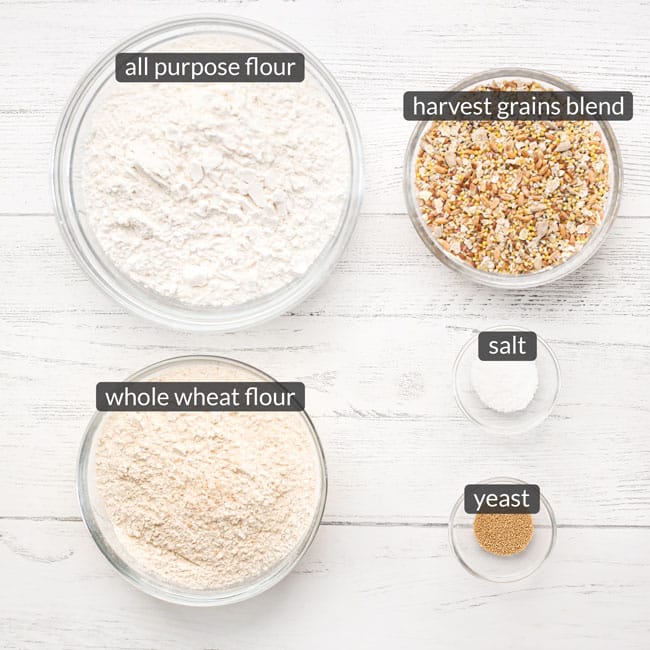
Ingredients
Click “Jump to the Recipe” at the top of the page or keep on scrolling down to the recipe card for ingredient amounts and full instructions. Below you’ll find helpful tips and tricks for all your burning bread-making questions!
- Flour – Both all-purpose and whole wheat. It isn’t ideal to use only whole wheat flour, as it has a tendency to result in dense bread.
- Multigrain blend – If you can’t find a pre-made multigrain or harvest blend, check out my easy recipe below!
- Salt – Use as much or little as you like.
- Yeast – You can use instant or active dry yeast.
- Water
How to make a multigrain blend
Also known as Harvest Blend, this is actually a little more difficult to come by. I searched far and wide! While I’ve seen some available online, I couldn’t find it at my local grocery store. No problem, though! I went to the nearest bulk bard and spent a whopping $3 on everything I needed to put together my own custom multigrain blend:
- rye flakes, 2 tbsp
- wheat flakes, 2 tbsp
- oat berries, 2 tbsp
- millet, 2 tbsp
- barley flakes, 2 tbsp
- 7-grain cereal, 2 tbsp
- flaxseed, 1 tbsp
- poppy seeds, 1 tbsp
- sesame seeds, 1 tbsp
- sunflower seeds, 1 tbsp
Yes, yes; I know. It’s a long list! Keep it simple, if you’d like. You can leave some of these ingredients out and add more of your favorites. The mixture I have here will add up to, exactly, one cup. So, if you get rid of something, make sure to substitute it using extra from another ingredient on the list.
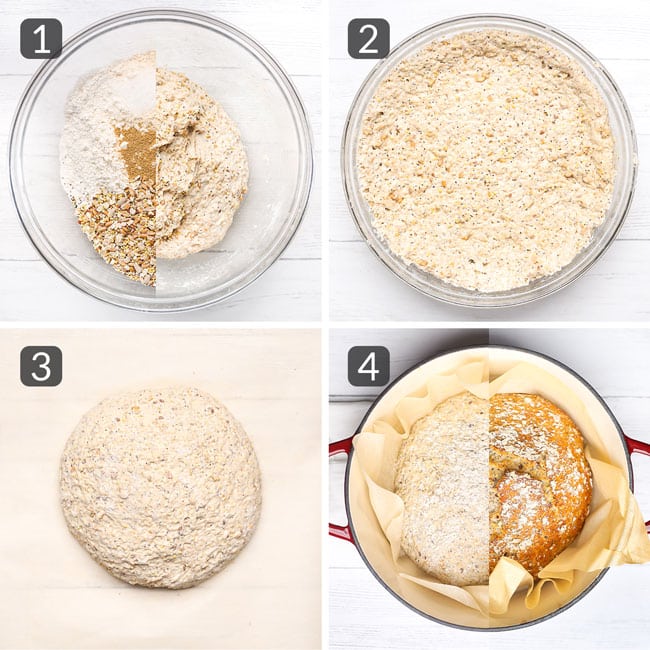
How to make no knead multigrain bread
- Dry ingredients: Stir the flours, multigrain blend, salt, and yeast together in a large mixing bowl.
- Finish the dough & rise: Add the water and stir with a wooden spoon until a dough forms. It should be sticky, but still pulling from the side of the bowl.* Cover the bowl with plastic wrap and let the dough rise in a warm, draft-free environment for 12-18 hours.
- 2nd rise: Flour your hands well, and run them around the edges of the dough in the bowl to loosen it. Shape the dough into a ball and place it onto a floured piece of parchment paper. Cover loosely with plastic wrap, and let the dough rise for 30 minutes.
- Bake: Set the oven to 450F and let the cast iron pot, with the lid, preheat inside the oven. When the oven reaches temperature, carefully take the pot out of the oven. Pick up the four corners of the parchment paper to lift the dough and place it inside the dutch oven. Bake for 30 minutes with the lid on, remove the lid, then bake for another 10-20 minutes until the loaf has browned to your preference.
To crunchy crust or to soft crust; that is the question
You’ll notice that the no knead multigrain bread will come out of the oven with an ultra-crunchy crust. Will it stay that way? You decide!
Let the dough cool completely to room temperature uncovered if you want to keep that crust crusty.
Let the dough cool for 20 minutes uncovered, then gently wrap the loaf in a clean kitchen towel until it has reached room temperature. This will trap a bit of steam and soften the crust a bit for you.
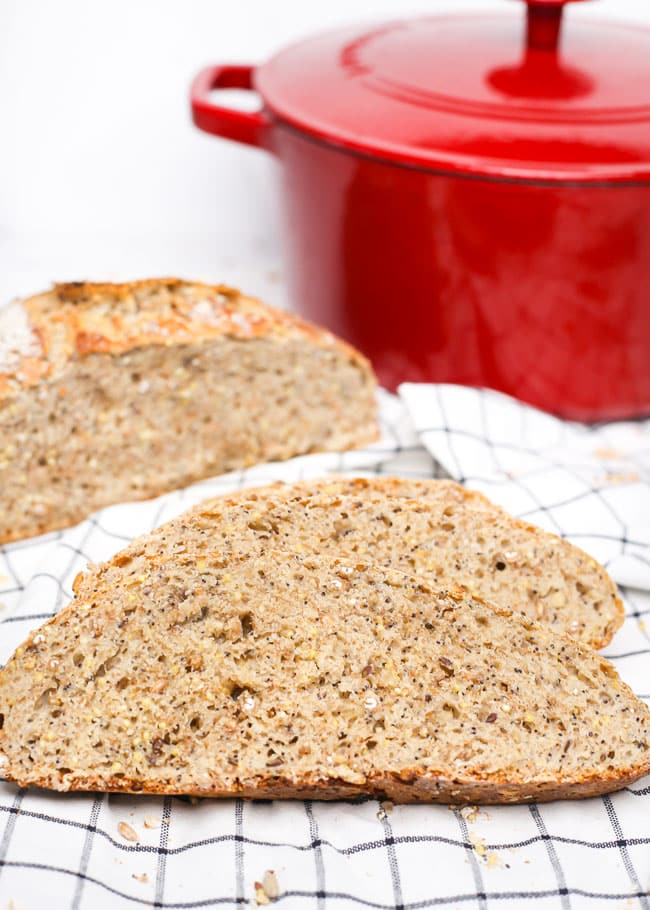
Tips, tricks, and troubleshooting no knead multigrain bread
Bread is so simple, yet so picky. Once you’ve tried and tested a few yeast bread recipes and you get the hang of it, you’re set. If you’re new to bread-making, you won’t exactly be able to make decisions with feel. Until you get to that point, here are some great tips that should help you get there faster!
- Every environment is different. Humidity plays a big role!
- If the dough feels too sticky, add more flour. This dough will be sticky, but you still want it to pull from the sides of the bowl.
- If the dough feels dry, add a bit more water.
- Not sure how old your yeast is? Test it! Add 1/2 tsp to about 1/2 cup lukewarm water with a sprinkle of sugar. Let the mixture sit for 5-10 minutes. If the yeast foams up, you’re good to go. Not so much? Grab a new jar.
- The longer the better! 12-18 hours will do the trick, but the closer you get to 18 the better. Especially with dense whole wheat flour. This long rise is what gives you gluten formation to result in soft, gorgeous bread without any kneading.
- Let your dough rise in the oven. We need a warm, draft-free environment for your dough to rise properly. The oven, turned off, of course, is the perfect spot!
- Need to use your oven to bake something? No problem. Just take the dough out for that time and pop it back in once the oven has cooled down to no higher than 150F.
- Leave a note! I like to tape a little note on the oven to make sure anyone in the kitchen will take the bowl out before turning the oven on while my dough is rising.
My dough didn’t rise
This is almost always a yeast issue. You will notice whether or not your dough is rising within 2-3 hours of mixing the ingredients.
- Make sure you use room-temperature water. Not hot or cold.
- Test your yeast if you aren’t sure how old it is. Keep in mind yeast is a living organism and can die before the expiry date. Check out #2 in the section above to see how to test yeast.
- Warm and draft-free is a must for rising dough! If letting it rise in a turned-off oven isn’t an option make sure to find a spot in the kitchen that isn’t hit with cold air.
- Lastly, keep that yeast in the freezer. This method of storage will keep your yeast fresh and thriving much longer.
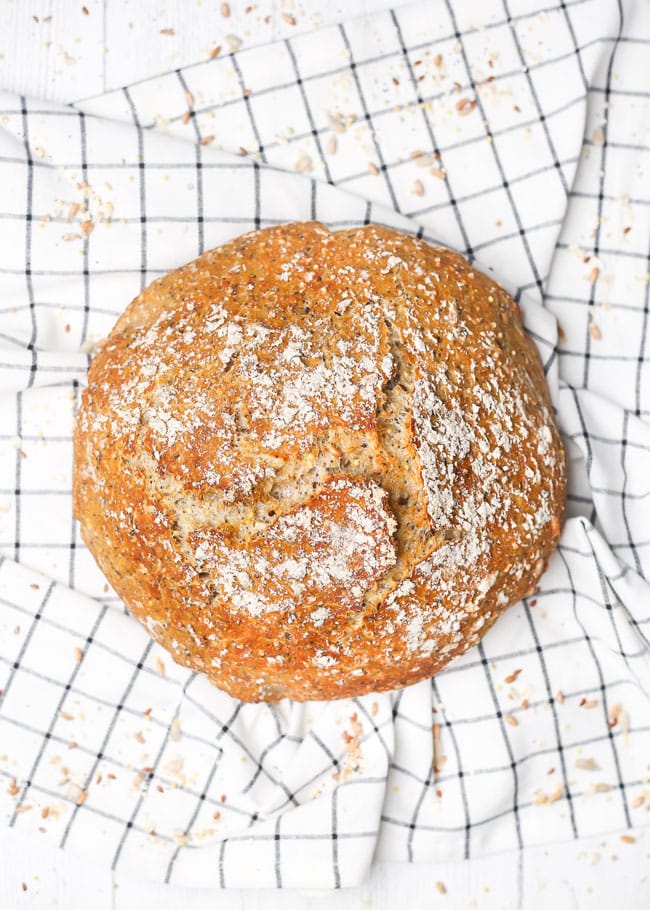
Choosing the right pot for no knead multigrain bread
The pot may be the most integral piece of this bread-making puzzle! A dutch oven is an ideal vessel. This enameled cast iron pot Has wonderful heat retention and can withstand high temperatures in your oven. Not only does it make fantastic bread, but it’s wonderful for making stews, soups, or anything braised. All hail dutch ovens!
If you don’t feel like going out and hunting one down, check out what you have for pots in your kitchen. You need something deep enough for the bread to rise, something that has a fitted lid, and something that can handle the 450F oven. Does it meet those three criteria? It will work!
With all that being said, I have one last piece of advice. Maybe you have a blessed inventory of cookware in the kitchen, and you’re choosing between a few pots. Size matters here! Your dough will spread as it bakes. A smaller pot will give you a taller loaf, and a large pot will give you a thinner loaf. I hope that helps the decision making!
How to store homemade bread
Homemade bread is always best enjoyed fresh. It will last 3-4 days stored in a breadbox, cake plate with a dome, wrapped with plastic, or in a sealable bag. This will prevent the bread from drying out but will soften the crust a bit.
You can also store the bread in the fridge for about one week. Again, keep it wrapped up to avoid having it dry out.
To store your bread in the freezer, make sure it has completely cooled down to room temperature. Wrap the bread well with plastic wrap, and store in an airtight container. It will last for up to 3 months frozen. Let it thaw at room temperature before slicing.
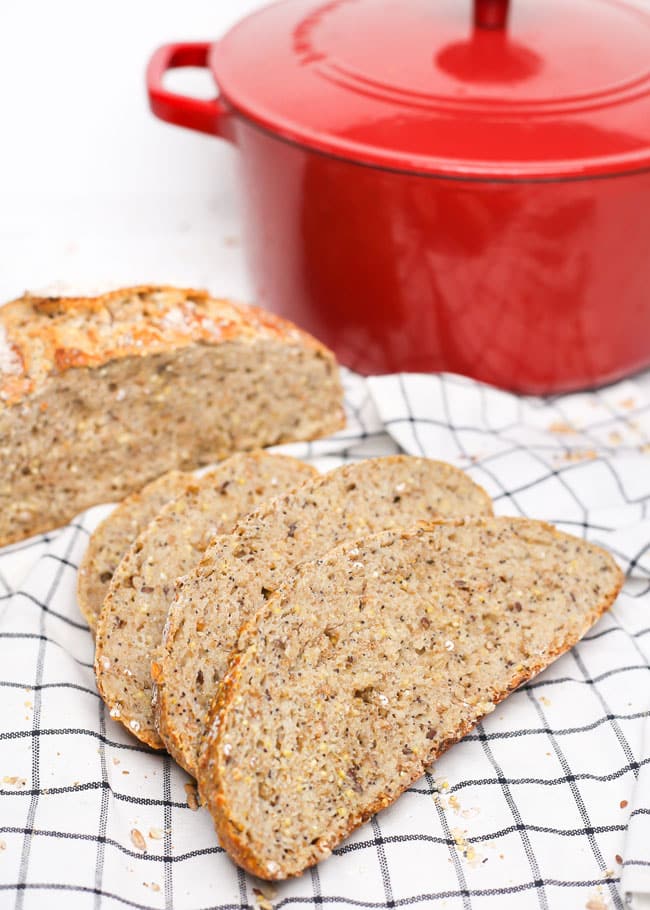
Looking for more simple recipes like this?
- Homemade Hamburger Buns
- Sourdough Bread
- One Pan Pork Chops and Potatoes
- Maple Soy Glazed Salmon
- No Bake Oatmeal Energy Balls
[ss_social_follow]
No Knead Multigrain Bread
Equipment
- Dutch Oven Pot
Ingredients
- 2 1/2 cups all-purpose flour
- 1 1/2 cups whole wheat flour
- 1 cup multigrain blend
- 1 tbsp salt or to taste
- 1 tsp yeast
- 2 cups water room-temperature
Instructions
- Before starting, make sure you have a dutch oven pot. Check the recipe notes for alternatives. Stir the flours, multigrain blend, salt, and yeast together in a large mixing bowl.
- Add the water and stir with a wooden spoon until a dough forms. It should be sticky, but still pulling from the side of the bowl.* Cover the bowl with plastic wrap and let the dough rise in a warm, draft-free environment for 12-18 hours.
- Flour your hands well, and run them around the edges of the dough in the bowl to loosen it. Shape the dough into a ball and place it onto a floured piece of parchment paper. Cover loosely with plastic wrap, and let the dough rise for 30 minutes.
- Set the oven to 450F and let the pot, with the lid, preheat inside the oven. When the oven reaches temperature, carefully take the pot out of the oven. Pick up the four corners of the parchment paper to lift the dough and place it inside the dutch oven. Bake for 30 minutes with the lid on, remove the lid, then bake for another 10-20 minutes until the loaf has browned to your preference.
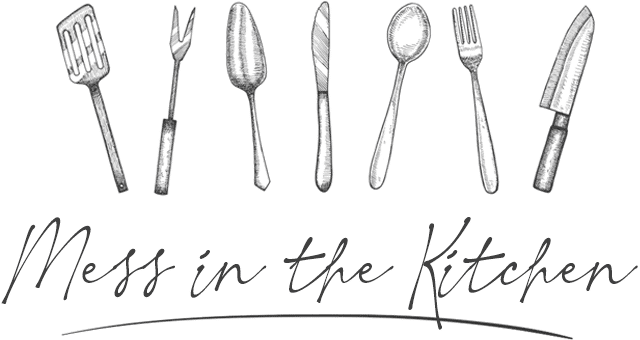
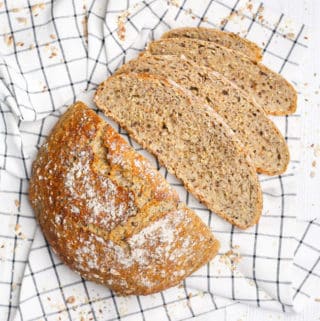
Leave a Reply